Kodungallur
Kodungallur (also English: Cranganore / K-town; Portuguese: Cranganor; formerly known as Mahodayapuram, Vanchi, Muyirikkode, and Muziris) is a historically significant town and a municipality on the banks of river Periyar on the Malabar Coast in Thrissur district of Kerala, India. It is situated 29 kilometres (18 mi) north of Kochi (Cochin) by National Highway 66. Kodungallur, being a port city at the northern end of the Kerala lagoons, was a strategic entry point for the naval fleets to the extensive Kerala backwaters.
Kodungallur
Cranganore | |
|---|---|
Municipal town | |
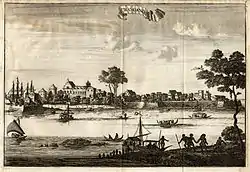 Dutch East India Company ships in Kodungallur (1708) | |
| Nickname(s): First Emporium of India | |
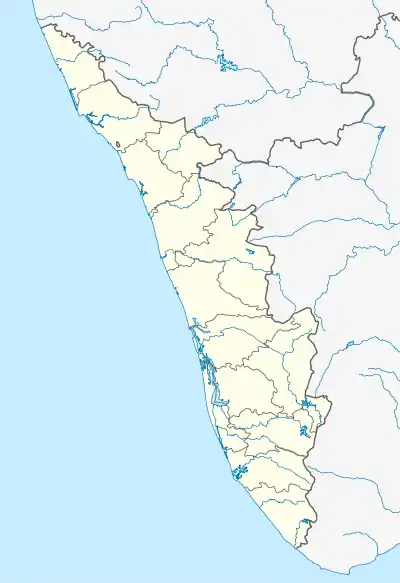 Kodungallur  Kodungallur | |
| Coordinates: 10.233761°N 76.194634°E | |
| Country | India |
| State | Kerala |
| District | Thrissur |
| Government | |
| • Body | Kodungallur Municipality |
| Area | |
| • Total | 40.62 km2 (15.68 sq mi) |
| Elevation | 9 m (30 ft) |
| Population (2011) | |
| • Total | 94,883 |
| • Density | 2,300/km2 (6,000/sq mi) |
| Languages | |
| • Official | Malayalam · English |
| • Spoken languages | Malayalam |
| Time zone | UTC+5:30 (IST) |
| PIN | 680664 |
| Telephone code | 0480 |
| Vehicle registration | KL-47 |
As of the 2011 India Census, Kodungallur Municipality and Out Growth (Grade II) had a population of 60,190. It had an average literacy rate of 95.10%.[1] Around 64% of the population follows Hinduism, 32% Islam and 4% Christianity. Schedule Caste (SC) constitutes 7.8% while Schedule Tribe (ST) were 0.1% of total population in Kodungallur.[2]
Kodungallur is the headquarters of the Kodungallur sub-district (tehsil) in Thrissur district.[2] Kodungallur Kerala Legislative Assembly constituency is a part of Chalakudi Lok Sabha Constituency.[3] Kodungallur is well connected to other towns in Kerala through the road network. Aluva Railway Station in Ernakulam district (28 km) is the major railway station near Kodungallur.
Fort Cranganore (Fortaleza São Tomé), known locally as Kottappuram Fort/Tipu's Fort, was constructed in Kodungallur by Portuguese in 1523. The fort was enlarged in 1565, and passed into the hands of the Dutch in 1663.[4][5] Thiruvanchikulam Mahadeva Temple, dedicated to the god Siva, is one of the major Siva temples in South India. Siva in the Thiruvanchikulam temple was the patron deity of the Chera Perumals of Kerala and remains the family deity of the Cochin Royal Family.
Etymology
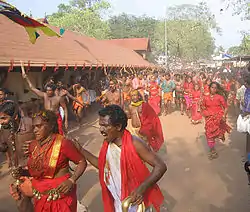
Origin of the modern name 'Kodungallur' has multiple interpretations:
- From koṭuṁ-kall-ūr, meaning 'place of the grand stone', because of a huge stone that the Chera king Cheran Chenguttuvan brought from the Himalayas to establish a shrine dedicated to the legendary Tamil woman Kannagi.
- From koṭuṁ-kōl-ūr, meaning the 'city of good governance'. ('kōl' literally means a sceptre)
- From koṭuṁ-kāḷi-ūr because of the existence of temple dedicated to goddess Kali.
- From koṭuṁ-kolai-ūr, meaning a 'bloody killing field', because of a 16th-century battle between Zamorin of Calicut and Kingdom of Cochin which was fought here.
In the medieval period (from c. 9th century CE), Kondungallur was part of the city of Makothai Vanchi (Sanskrit: Mahodaya Pura, Malayalam: Mahodaya Puram). It was the seat of the Kerala branch of the Chera clan, the Perumals, for about three hundred years.[6] Kodungallur is well known in ancient times due to trade, and also due to the Baghavathy kshethram, and as well as the seat of Kannagi's resting place in the ksethram, after she burns down the capital of the Pandya rulers Madurai, who falsely accuse her husband of stealing the anklet of the royal Queen. This is steeped in the folklore of Kerala and Tamil Nadu, which is evident in the temple festivals, and has it roots in Dharma, which the Pandya ruler failed to follow, and incurs the wrath of the chaste Kannagi. This is also the story of the classical Tamil epic Silappatikaram, written by royal born, but later turned ascetic Ilango Adigal, brother of the Chera King Sengottuvan. It was also known as Muchiri Pattanam, Muyirikkode, Mahavanchimana Pattanam, and Thrikulasekarapuram.
Kodungallur was also known as Jangli, Gingaleh, Cyngilin, Shinkali, Chinkli, Jinkali, Shenkala, and Cynkali, which are all derived from the name of the River Changala (or the Chain River, i.e., Shrinkhala in Sanskrit), a tributary of the Periyar.[7]
History
Early historic harbour
Scholars believe that Muziris, an ancient harbour located on the mouth of Periyar, coincides with modern-day Kodungallur. Central Kerala and western Tamil Nadu in early historic south India was ruled by the Chera line of rulers.

The harbour was visited by navigators from all over the world, especially from the Mediterranean world. The Roman Empire had a continuous trading connection with the West Coast of India. Along with spices (pepper), commodities such as pearls, muslin, ivory, diamonds, silk and perfumes were acquired by the sailors from central Kerala.[8]

A traditional belief among the ancient Christians in Kerala is that Apostle St. Thomas landed in or around Kodungallur[5] in the middle of the 1st century CE and founded Seven Churches: Kodungallur, Niranam, Nilackal (Chayal), Kokkamangalam, Kottakkavu, Palayoor and Aruvithura – a "Royal Church".[9][10][11]
Sometime between the 4th and 8th century, the Knanaya Community is believed to have arrived from the Middle East under the leadership of the Syrian merchant Thomas of Cana. The community settled on the southern side of Cranganore and eventually established three churches in the names of St. Thomas, St. Kuriakose, and St. Mary. The Knanaya left their settlement after its destruction during a battle between the Kingdom of Cochin and Zamorin of Calicut in the 16th century.[12]
According to one tradition, a Cochin Jew colony in Malabar Coast, probably established before the 6th century BCE, attracted the Apostle to this region.[13] The native Muslim tradition holds that the Cheraman Mosque in Kodungallur, "built in 629 CE by Mālik bin Dīnār", is the oldest mosque in South Asia.[14][15][16]
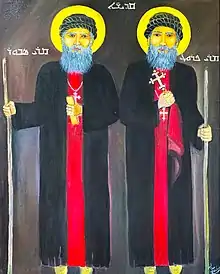
Medieval port of Kodungallur
The economic and political prestige of the harbour of Kodungallur remained even in medieval South India. Sulaiman, a West Asian visitor to India during this period, recorded the "economic prosperity" of the region. Also, he describes the Chinese traders in the city; they are described as purchasing articles such as spices (pepper and cinnamon), ivory, pearls, cotton fabrics and teak wood.[8]
The port was sacked by the Chola rulers in the 11th century CE.[6] After the dissolution of the Chera Perumal rule (early 12th century CE), Kodungallur emerged as a principality, named Padinjattedathu Swaroopam, under the control of the royal family of Kodungallur Kovilakam. The city state was "allied" either to the kingdom of Cochin (Kochi) or to Calicut (Kozhikode).[6]
It is postulated that the harbour at Kodungallur was devastated by natural calamities—a flood or an earthquake—in 1341, and consequently lost its commercial/strategic importance thereafter.[17] Consequently, the trade got diverted to other ports of the Malabar Coast, such as Cochin (Kochi) and Calicut (Kozhikode).[18] It is speculated that the floods split the left branch of the River Periyar into two, just before the town of Aluva. The flood silted the right branch (known as the River Changala) and the natural harbour at the mouth of the river to make it poorly navigable for large vessels.[19]

Portuguese era
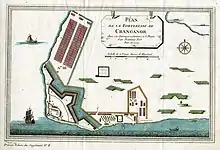
Portuguese navigators began operating in South India from the early 16th century CE. During this period, Kodungallur was a "tributary state" of the kingdom of Kozhikode (Calicut) of Zamorins (Samoothiris). Since Kodungallur was sandwiched between the kingdom of Kozhikode and the kingdom of Kochi, it was a matter of frequent dispute for both the kings. The chieftain of Kodungallur often switched allegiance from one king to another.[21]
The Portuguese spice trade was challenged by the kings of Kozhikode in the Indian Ocean. The port of Kodungallur had a sizeable Jewish, native Christian and Muslim population at the time.[22][21] Portuguese Company extended their aggression on Calicut to allied coastal city-states, including Kodungallur. The port was almost completely destroyed by the Portuguese (Suarez de Menezes) on 1 September 1504.[23]
Kodungallur, being a port city at the northern end of the Vembanad lagoon, was a strategic entry point for Zamorin's army and fleet into the Kerala backwaters. Hence, in October 1504 Zamorin dispatched a force to fortify Kodungallur. Reading this movement as a preparation for a renewed attack on Kochi, the Portuguese commander, Lopo Soares, ordered a preemptive strike. A squadron of around ten fighting ships, accompanied by numerous fighting boats from Kochi, headed up to Kodungallur. The heavier ships, unable to make their way into the shallow channels, anchored at Palliport (Pallipuram, on the outer edge of Vypin island), while the smaller frigates progressed to the destination.
Converging on Kodungallur, the Portuguese-Kochi fleet quickly dispersed the Calicut forces on the beach using cannons, and launched their composite army – some 1,000 Portuguese soldiers and 1,000 Nair warriors of Kochi – who took on the rest of the enemy force in Kodungallur.[24] The assault troops captured and sacked the city of Kodungallur, and was set on fire by the squads led by Duarte Pacheco Pereira and Diogo Fernandes Correa. Nonetheless, according to some records, Portuguese arsonists spared the Saint Thomas Christian quarters in the city. (At the time the community was in a tenuous position: though thriving in the spice trade and protected by their own militia, the local political sphere was volatile and the Saint Thomas Christians had found themselves under pressure from the rajas of Calicut, Cochin and other small kingdoms in the area. Hence the community had sought an alliance with the Portuguese newcomers. Since they were one of the major suppliers of pepper in the region, the Portuguese also found the relationship reciprocating.[25]) This might have helped the ancient Christian community of Kodungallur from extinction during the 1504 assault on the city.
Calicut fleet
_Photo_by_Fedor_Jagor%252C_Ethnologisches_Museum%252C_Staatlichen_Museen_zu_Berlin.jpg.webp)
The Calicut fleet, some five ships and 80 paraus, that had been dispatched to save the city was intercepted by the idling Portuguese ships near Palliport and defeated in a naval encounter.[26] In the meantime, the raja of the Kingdom of Tanur (Vettattnad), whose kingdom lay to the north, on the road between Calicut and Kodungallur, and who had a spoiled relation with the Zamorin, offered to place himself under Portuguese suzerainty. It is recorded that the military of Calicut, which was led by Zamorin in person, was defeated on their way to Kodungallur by a sizeable Portuguese army with the assistance of the Tanur ruler.
The raid on Cranganore and the defection of the Tanur raja were serious setbacks to the Zamorin of Calicut, pushing the frontline north and effectively placing the Vembanad lagoon out of the Zamorin's reach. The battle set the scene for Portuguese to expand their colonial authority over a significant area of the Malabar coast. By 1510, their fluid power in the Malabar coast solidified into a perceptible territorial entity.[21]
In 1662, the Dutch entered the competition, sacked the Portuguese in a fortnightly war, with the help of Zamorin, and occupied Kodungallur.[27] The Dutch took the control of Kodungallur fort in 1663 and it eventually protected southern Kerala, especially Travancore, from the Mysorean invasion in 1776. In 1786, Mysorean troops again marched to northern Kerala, but failed to progress ahead of Kodungallur. On 31 July 1789, the Dutch handed over their establishments in Kodungallur and Azhikode to the Kingdom of Travancore for 300,000 Surat silver rupees.[28]
Muziris Heritage Project
The Muziris Heritage Project was launched by the Government of Kerala's Department of Cultural Affairs in 2006 to "scientifically retrieve and preserve the historical heritage of the region, extending from North Paravur to Kodungallur". The Kerala Council for Historical Research (KCHR), identified as the nodal agency for the Muziris Heritage Project, provides academic guidance and undertakes archaeological and historical research in the region.[29]
See also
References
- "India Census 2011".
- "Profile". Janasevana Kendram. Archived from the original on 24 March 2011. Retrieved 7 December 2010.
- "Assembly Constituencies – Corresponding Districts and Parliamentary Constituencies" (PDF). Kerala. Election Commission of India. Archived from the original (PDF) on 4 March 2009. Retrieved 19 October 2008.
- "Kottappuram fort". muzirisheritage.org. Kerala Tourism Department. Retrieved 24 August 2012.
- Chisholm, Hugh, ed. (1911). . Encyclopædia Britannica. 15 (11th ed.). Cambridge University Press. p. 885.
- A Sreedhara Menon (1 January 2007). A Survey of Kerala History. DC Books. p. 126. ISBN 978-81-264-1578-6. Retrieved 22 August 2012.
- For a large number of such names for Kodungallir down the centuries arranged more or less chronologically cf. K. P. Padbhanabha Menon, History of Kerala Vol. I, quoted by George Menachery in Kodungallur, 1987, reprinted 2000.
- A Sreedhara Menon (1 January 2007). A Survey of Kerala History. DC Books. p. 127. ISBN 978-81-264-1578-6. Retrieved 22 August 2012.
- James Arampulickal (1994). The pastoral care of the Syro-Malabar Catholic migrants. Oriental Institute of Religious Studies, India Publications. p. 40.
- Orientalia christiana periodica: Commentaril de re orientali ...: Volumes 17–18. Pontificium Institutum Orientalium Studiorum. 1951. p. 233.
- Adrian Hastings (15 August 2000). A World History of Christianity. Wm. B. Eerdmans. p. 149. ISBN 978-0-8028-4875-8.
- Pius Malekandathil (2003). Jornada of D. Alexis Menezis: A Portuguese Account of Sixteenth Century Malabar. LRC Publications. pp. 19–20.
- Abraham Mattam (Mar)) (2001). Forgotten East: Mission, Liturgy and Spirituality of the Eastern Churches : a Study with Special Reference to the Church of St. Thomas Christians. Ephrem's Publications. p. 148. ISBN 978-81-88065-00-4.
- Dan Landis; Rosita D. Albert (14 February 2012). Handbook of Ethnic Conflict: International Perspectives. Springer. p. 141. ISBN 978-1-4614-0447-7. Retrieved 22 August 2012.
- "World's second oldest mosque is in India". Bahrain tribune. Archived from the original on 6 July 2006. Retrieved 9 August 2006.
- Cheraman Juma Masjid A Secular Heritage
- Ashis Nandy (1 January 2002). Time Warps: Silent and Evasive Pasts in Indian Politics and Religion. Hurst. pp. 172–. ISBN 978-1-85065-479-7. Retrieved 28 August 2012.
- "History of Kochi". Centre For Heritage Studies, India. Archived from the original on 15 September 2015. Retrieved 5 September 2010.
- A Sreedhara Menon (1 January 2007). A Survey of Kerala History. DC Books. p. 18. ISBN 978-81-264-1578-6. Retrieved 22 August 2012.
- Anjana Singh (30 April 2010). Fort Cochin in Kerala, 1750-1830: The Social Condition of a Dutch Community in an Indian Milieu. BRILL. p. 233. ISBN 978-90-04-16816-9. Retrieved 29 August 2012.
- Pius Malekandathil (2010). Maritime India: Trade, Religion and Polity in the Indian Ocean. Primus Books. pp. 90–. ISBN 978-93-80607-01-6. Retrieved 23 August 2012.
- Sanjay Subrahmanyam (29 October 1998). The Career and Legend of Vasco Da Gama. Cambridge University Press. pp. 293–294. ISBN 978-0-521-64629-1. Retrieved 26 July 2012.
- Yosef Kaplan (2008). The Dutch Intersection: The Jews and the Netherlands in Modern History. BRILL. p. 65. ISBN 978-90-04-14996-0. Retrieved 23 August 2012.
- Castanheda, p.272
- Frykenberg, Eric (2008). Christianity in India: from Beginnings to the Present, 122–124. Oxford University Press. ISBN 0-19-826377-5.
- Mathew (1997: p.14)
- K. K. Kusuman (1987). A History of Trade & Commerce in Travancore, 1600–1805. Mittal Publications. ISBN 978-81-7099-026-0. Retrieved 28 August 2012.
- Anjana Singh (30 April 2010). Fort Cochin in Kerala, 1750-1830: The Social Condition of a Dutch Community in an Indian Milieu. BRILL. pp. 86, 149, 158. ISBN 978-90-04-16816-9. Retrieved 28 August 2012.
- "Kerala Council for Historical Research". Archived from the original on 2 May 2012. Retrieved 24 August 2012.
External links
| Wikimedia Commons has media related to Kodungallur. |
| Wikisource has the text of the 1911 Encyclopædia Britannica article Kodungalur. |